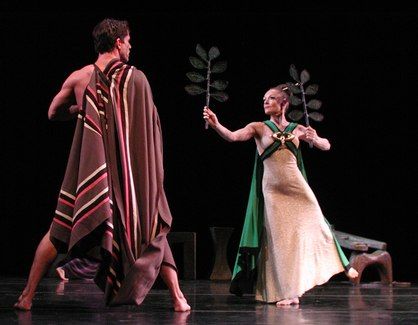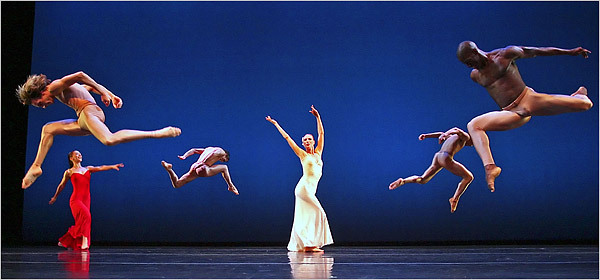Martha Graham Dance Company



 debauchery
debauchery
The Martha Graham Dance Company gave a fabulous performance this weekend at The Power Center. I attended on Friday night, though they held performances on both Saturday, and Sunday (for families and children). I was late to the box office so I missed the first two pieces- a video montage by UM dance professor Peter Sparling and a Mary Wigman adaptation called “Witch Dance” (shown above). Unfortunately, therefore, I don’t have much to report on those two, except that I learned that there are tv’s stationed outside the theater doors so that late comers can at least glimpse the action on the stage within.
Once inside, I sat to enjoy the three main pieces of the evening. The first was called “Every Soul is a Circus.” One of Martha Graham most famous pieces, it was first performed in 1939 starring Martha Graham herself plus her student at the time and famous choreographer-to-be, Merce Cunningham. The story line followed a woman who imagined herself as the apex of a lover’s triangle between herself, The Empress of the Arena, The Ring Master and The Acrobat. With theatrical props such as whips, stools, balancing beams, curtains, and ribbons of fabric hanging from the ceiling, the set what an unmistakable gilly. The color scheme was bright and bold. Orange, yellow, red, pink, blue, and green glowed in the stark lighting as animated elements of the story. I understood a great deal of the plot from watching the movement of the dancers and the spatial relationships between them, but the program shed more light on the undertones of the masterpiece. At the time of Martha Graham’s choreography, Freud was becoming popular in the United States. She was influenced by his deep and unexpected inner psychological theories. Her story “Every Soul is a Circus” tells of our unconscious fantasies, the debauchery of our desires and self-absorption.
The second piece was a three part recreation of Graham’s famous solo piece “Lamentations.” In 2007, the Martha Graham Company performed a tribute to September 11th. Under the artistic direction of three choreographers, the company designed and performed three pieces within 10 hours each. They are entitled “Lamentation Variations” and all struck a chord with the audience of deep sorrow and longing. The first featured four nearly nude dancers moving languidly to operatic singing. The third piece showcased the entire company. Dressed in pedestrian clothing, they mimicked a street scene of citizens who each experienced loss and comfort among each other. The second piece was the most striking of the night. It featured one female dancer who, for the duration of the dance, moved slowly and jerkily from one end of the stage to the other. Struggling to advance, she stepped toward a glaring spotlight, accompanied by a screeching, heavenly chorus of metallic angel’s voices. It was strong because of its simplicity; it pushed the concept of a “dance” in a pensive and elegant way.
The final piece of the evening was called “Night Journey.” It was an adaptation of the myth of the Oedipus complex, though it was told from the point of view of the mother, Jacosta. Like the first piece, the theme was inspired by Freud’s influence on the American psyche. The dance was colorful and seamless, involving large props and flowing costumes. The interaction between Jacosta and her son, Oedipus, was highly sexualized and lustful, though infused with intermittent and distorted flashbacks of her lover as her infant. The sexual display was not shocking to the Power Center audience of 2013, though I imagine when the piece debuted in 1947 it was quite scandalous.
After the show, Peter Sparling, the company’s artistic director, and the dancers who portrayed Oedipus and The Empress of the Arena held a Q&A in the auditorium. What I learned about the company was that they were deeply impacted by the destruction of Hurricane Sandy. Their entire warehouse of original costumes and sets was submerged in water for almost two weeks. They are just beginning the process of restoration, though a rich history of the culture and the company was lost in the storm.
At the very end of the evening, I approached the stage and introduced myself to Katherine Crockett, the principal dancer. She is famous for many dof her roles including Cate Blanchett’s double in “The Curious Case of Benjamin Button.” This may seem like a forward move on my behalf but it was a prearranged meeting. My aunt is a dance teacher for many of the major companies in NYC. Katherine Crockett is one of her best students. I told her to say hi to my aunt for me next time she takes her class. She was so genuine and excited to meet me- nothing at all like her cooky role as the Empress of the Arena. A true performer!










